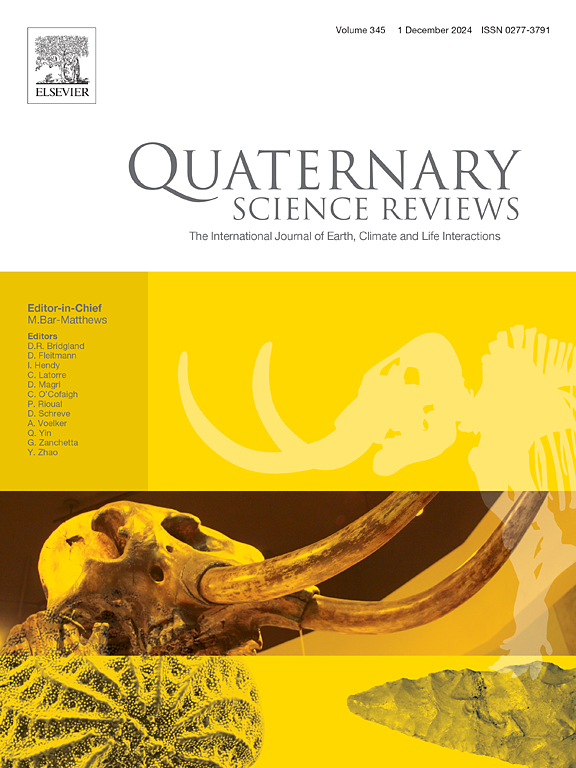校正花粉数据揭示的华南全新世长期变暖趋势
IF 3.3
1区 地球科学
Q1 GEOGRAPHY, PHYSICAL
引用次数: 0
摘要
全新世的温度变化及其作用力是当前和未来气候变暖趋势的重要参考。然而,代用指标重建与全新世温度演变模型模拟之间存在着巨大差异。花粉证据往往是造成这些差异的核心原因,但却被批评为可能反映了人类的影响而非纯粹的温度变化,从而使我们对全新世温度变化的理解变得更加复杂。我们的研究聚焦于华南地区,该地区的模型与代用指标之间存在明显差异。我们介绍并验证了一种从花粉数据中分离出真实温度信号的新方法。这种方法采用了基于树栖花粉的温度指数,并利用大遗址植被丰度区域估算(REVEALS)模型纠正了原始花粉数据中固有的偏差。利用这种方法,我们基于罗霄山脉的两块花粉化石数据,提出了过去一万年的冬季/年温度新记录。同时,我们还重建了人类活动对该地区的历史影响。我们的温度记录揭示了全新世期间持续变暖的趋势,与模型模拟的年平均温度(R = 0.97)以及基于区域陆地和海洋档案中支链甘油二烷基甘油四醚的温度重建结果非常吻合。相比之下,未经校正的花粉数据显示全新世晚期出现了降温趋势,这与大约公元前 3 ka 年以来人类的重大影响相吻合。我们的分析以及与现有温度记录的区域对比表明,这种截然不同的温度趋势源于人类引起的降温偏差,这在未经校正的花粉数据中尤为明显。我们推断,全新世早期到中期的变暖是由各种因素造成的,而全新世晚期的变暖则主要是由当地的年日照变化造成的。我们的研究结果对之前根据未经校正的花粉数据广泛确定的全新世晚期变冷趋势提出了质疑,证明了校正花粉数据可以有效减轻温度重建中人为因素造成的变冷偏差。这项研究证实了气候模式模拟全新世气候变暖趋势的准确性,至少在华南地区的时间和空间上都是如此。本文章由计算机程序翻译,如有差异,请以英文原文为准。
Long-term Holocene warming trend in Southern China revealed by corrected pollen data
Holocene temperature changes and their forcings serve as pivotal references for current and future warming trends. However, significant discrepancies exist between proxy reconstructions and model simulations of Holocene temperature evolution. Pollen evidence, often central to these discrepancies, have been criticized for potentially reflecting human influence rather than pure temperature variations, complicating our understanding of Holocene temperature changes. Our study focuses on southern China, a region with pronounced discrepancies between models and proxies. We introduce and validate a novel methodology to isolate genuine temperature signals from pollen data. This approach employs an arboreal pollen-based temperature index and correct biases inherent in raw pollen data using the Regional Estimates of Vegetation Abundance from Large Sites (REVEALS) model. Applying this method, we present a new winter/annual temperature record for the past 10,000 years based on two fossil pollen data from the Luoxiao Mountains. Simultaneously, we reconstruct the historical impact of human activities in the region. Our temperature records reveal a sustained warming trend during the Holocene, closely matching model-simulated mean annual temperatures (R = 0.97), and temperature reconstructions based on branched glycerol dialkyl glycerol tetraethers from regional terrestrial and marine archives. In contrast, uncorrected pollen data indicate a cooling trend during the late Holocene, coinciding with significant human impact since approximately 3 ka BP. Our analysis and regional comparison with existing temperature records indicate that such contrasting temperature trends stem from a human-induced cooling bias, particularly pronounced in uncorrected pollen data. We infer that the early to middle Holocene warming was due to various factors, while late Holocene warming was predominantly driven by local annual insolation changes. Our findings challenge previously widely identified late-Holocene cooling trends based on uncorrected pollen data, demonstrating that the correction of pollen data can effectively mitigate human-induced cooling biases in temperature reconstructions. This study confirms the accuracy of climate models in simulating a Holocene warming trend, both temporally and spatially, at least in southern China.
求助全文
通过发布文献求助,成功后即可免费获取论文全文。
去求助
来源期刊

Quaternary Science Reviews
地学-地球科学综合
CiteScore
7.50
自引率
15.00%
发文量
388
审稿时长
3 months
期刊介绍:
Quaternary Science Reviews caters for all aspects of Quaternary science, and includes, for example, geology, geomorphology, geography, archaeology, soil science, palaeobotany, palaeontology, palaeoclimatology and the full range of applicable dating methods. The dividing line between what constitutes the review paper and one which contains new original data is not easy to establish, so QSR also publishes papers with new data especially if these perform a review function. All the Quaternary sciences are changing rapidly and subject to re-evaluation as the pace of discovery quickens; thus the diverse but comprehensive role of Quaternary Science Reviews keeps readers abreast of the wider issues relating to new developments in the field.
 求助内容:
求助内容: 应助结果提醒方式:
应助结果提醒方式:


